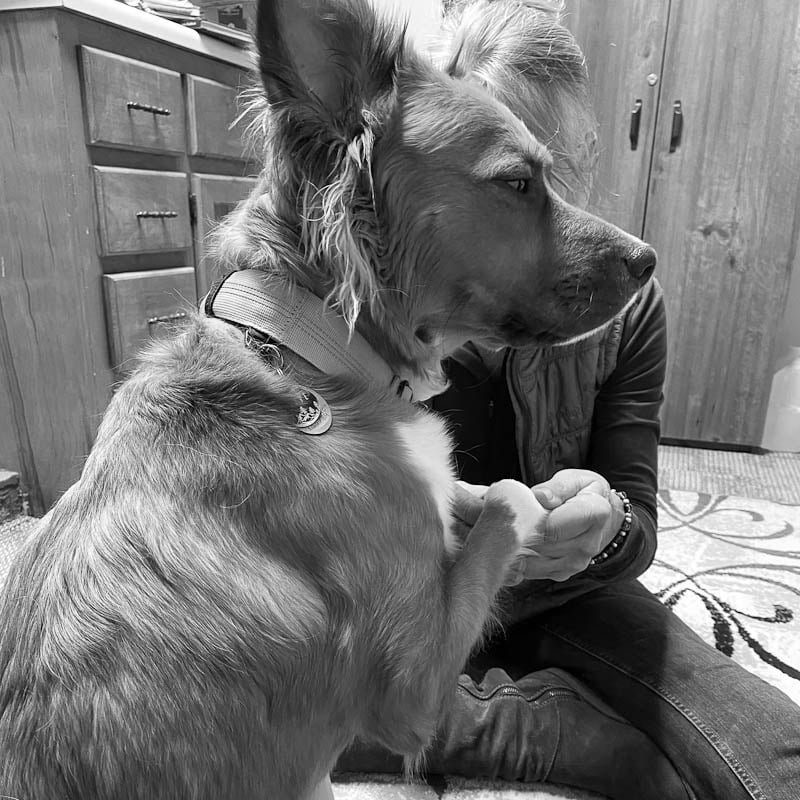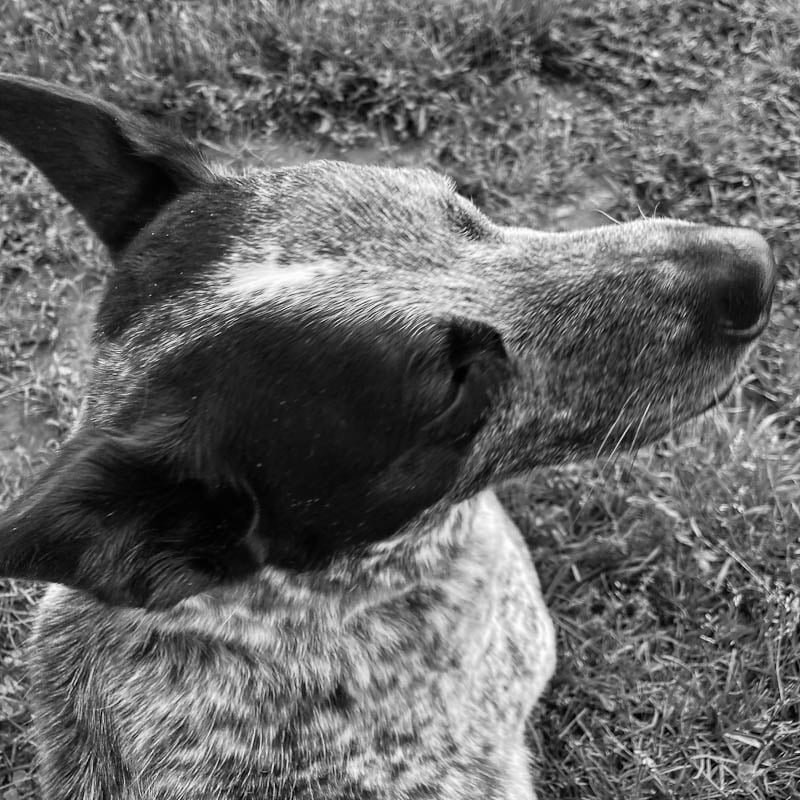
The Canine Touch is a gentle non-invasive touch that addresses the whole body specifically through the fascial network. The moves are made over muscle edges, tendons, ligaments and fascia. The touch communicates via deep neurological impulses through the nervous system to the brain.
The touch brings the dog into a parasympathetic state deeply relaxing the body. The dog is unrestrained allowing freedom to stay or leave at will, giving them control over their own needs but building trust and acceptance.
Canine Touch is considered a progressive modality facilitating neurological restoration. What is initiated at the first session is important to be followed up with two additional sessions at one week apart.
For more details, view the FAQ below.
What is your service area?
Our practice provides Canine Touch therapy primarily in the Northwest Arkansas region and surrounding areas.
What conditions can Canine Touch can help with?
Because of its ability to activate and accelerate the body's innate ability to heal itself, Canine Touch treatments can help a variety of conditions:
- Relieve chronic and/or acute pain
- Improve joint mobility
- Reduce pain and inflammation
- Realign postural imbalance and spinal misalignment
- Speed recovery from accidents and injuries
- Resolve shoulder and neck injuries
- Help growing pups maintain correct limb alignment
- Aid in digestive issues
- Help maintain balance in hip dysplasia
- Restore proper body function and balance
- Aid in lymph drainage
- Promotes healing and recovery both pre and post surgery
- Is great for elderly dogs who are stiff and where mobility has lessened
- Promotes health and well being
- Enhance performance of competition dogs
- and more!
If you aren't sure whether your canine friend is a candidate, feel free to contact me or talk with your veterinarian.
How does it work?
The unique moves of Canine Touch are applied with the thumbs and fingers with a stretch, pressing and releasing in such a way as to send a vibration, or a firing of impulse through the tissue resulting in a recoil and release.
During gentle soft tissue manipulation, the ‘firing’ of stimulus involves the central nervous system (CNS) where messages are relayed to the brain and the brain sends messages back to the body. One of the most important facets of this discipline is the goal of relaxation of the body, asking it to move out of a sympathetic state and into a parasympathetic state.
Being a holistic modality we see how interconnected the body really is, animals and people alike. As we begin to understand we are all energetic beings in physical form, we then create an even greater effect.
How can you tell what my dog needs?
At it's core, Canine Touch is a discipline rooted in trust and communication.
As dogs cannot tell us what’s wrong, we must listen to them through the touch and feel, between my hands and their body. Much is learned by observation of their body, their gait, their body language, how they respond, what they are accepting of, what they will not allow and also what they are asking for. The eyes, the ears, the facial expressions, even the texture and lay of the hair has a message.
How is Canine Touch different from other care modalities?
Canine Touch does not diagnose, but rather works to serve the whole body both physically and emotionally.
Because of the interconnectedness of the body and all its tissues, Canine Touch has the ability to affect the whole body both physically and emotionally. It is therefore a holistic approach.
When the body is at rest, it is then and only then that true healing can occur. During this relaxation state the body via the CNS (Central Nervous System) can trigger a release of hormones and substances that directly influence the state and health of the body. We are triggering the inborn, innate ability of the body to balance and heal itself.
Do you have training or certification?
Yes, I received my training through the The Canine Touch track of the Equine Touch Foundation and completed my certification in 2023. I invite you to read more about my journey.
What about my veterinarian?
Canine Touch is a complementary modality. It works in concert with other forms of care your pet receives, including allopathic veterinary medicine.
It is important to note that Canine Touch does not diagnose any condition or disease. If an area of concern is found during a session then additional moves may be performed with observation of the reaction of the dog and noting the state of the tissue. It is also possible that finding an area of concern can be of importance where additional veterinary attendance can alleviate a problem before it becomes a bigger issue.
If a dog is under veterinary care it is important to have their permission before a Canine Touch session. If your veterinarian has any questions, I am happy to speak with them. It is also of value to note that Canine Touch can be of positive benefit with allopathic treatment and as such is not a cure for any disease nor a replacement for veterinary medicine.

What to Expect at an Appointment
If you’ve never experienced a Canine Touch therapy session, you may be wondering what it will be like.
How long are sessions?
Typically sessions last from 20-45 minutes, however the first session may take a full hour to discuss your concerns, get a case history and to begin the introduction of your pet to their first Canine Touch experience.
What does a session look like?
The dog is not restrained and it is important to allow them to move about at will. Some dogs will have to wander for a bit. The beginning is always about the exploration of their body, my hands feeling and touching, looking for signs of inflammation, hot or cold areas, tight tissues or restrictions.
After this introductory period then I begin with the Canine Touch moves. These moves can have a very profound effect on the dog and you can begin to see them pay attention to something different. The basic moves help them to relax and they may lay down, or walk away then come back.
I will typically sit on the floor with your pet. At times I may be standing to deliver the moves or if it is a large dog. Other times it is a benefit to have a small dog sit on the owner’s lap or perhaps have them on a raised table to make treatment easier.
You will see the dog focus on his/her body and become quite “tuned in” and aware. Our job is to let the dog process the information and let them communicate how much they will accept, often telling me when a session is over.
How do dogs react during a session?
The moves themselves can soften tight muscles, reduce inflammation, increase blood flow and circulation and initiate lymph drainage. At times it is important to allow a short wait between moves to allow the dog’s body time to process what is happening. It is the communication between my hands and the dog that dictates how much is done.
Often during a session the dog will lay down and go to sleep. This is a deep response and of utmost importance to allow the dog time to process what is happening. I let them sleep as long as necessary, sometimes it is only a short snooze and then the session continues. Other signs of response include a yawn, sleepy eyes or even a wild eyed glance to “what did you just do with those hands!”
What is my role during a session?
The owner is present in the room and may be asked to aid in some cases by lightly holding the dog steady if they are unable to settle. In most cases the owner will be sitting nearby and observing. It is important to note it is recommended to NOT pet them. Many people are unaware of their petting for reassurance but this sends mixed messages to the dog's body. It is better to be present with the animal and reassure them with your mind and demeanor if necessary.
What about after the session?
The Canine Touch is noted for its continued effect after the session and the dog may continue to process for the next day or so. Please be sure and have plenty of fresh water available and allow them to go outside as needed to relieve themselves.
